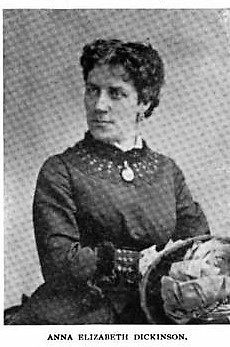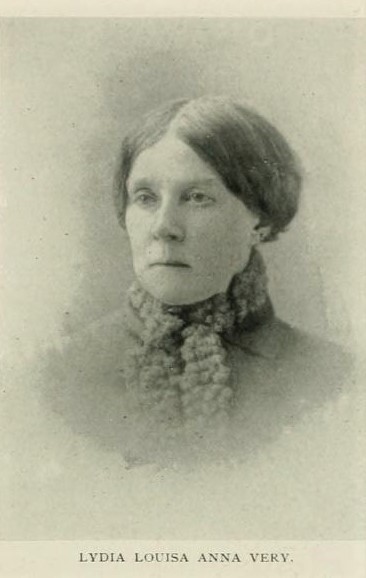October 27 - November 2
Women of the Week
Orator, author, playwright, actor, reformer, and philanthropist Anna Elizabeth Dickinson and author, educator, and artist Lydia Louisa Anna Very are this week's Women of the Week
-
To learn about them by viewing their items, please click on their images.
-
To read their biographical sketches in A Woman of the Century, please click on the highlighted page numbers to the left of their images.
DICKINSON, Mrs. Anna Elizabeth
October 28, 1842
orator, author, playwright, actor, reformer, philanthropist
Philadelphia, PA
Anna Elizabeth Dickinson was born on October 28, 1842, in Philadelphia, Pennsylvania. Her father passed away in 1844, when Anna was two years old. She went to the Friends' Free School, studied hard, and read constantly.
By the age of fifteen, Anna had written her first article on slavery and had spoken at a meeting for the Anti-Slavery movement. She taught in Berks County, Pennsylvania before becoming a professional lecturer. Anna traveled around New England delivering addresses about slavery, temperance, and politics. When Anna gave an address in Washington, D.C. during the early 1860s, she donated all of the proceeds from the event to the Freedmen's Relief Society.
Also a writer, Anna published the novel What Answer? in 1868. Next, she decided to pursue playwriting and acting. Anna wrote a play called "A Crown of Thorns" and made her debut on the stage. When this career path ultimately failed, she decided to return to lecturing and continued to write plays.
Anna died in Goshen, New York when she was eighty-nine. She is buried at Slate Hill Cemetery, Goshen, New York.
Lydia Louisa Anna Very was born on November 2, 1823, in Salem, Massachusetts, the youngest child of Jones and Lydia Very. Her father passed away when Lydia was just a year old.
In December of 1841, Lydia began teaching at Mason Street Public School in Salem, and by 1860, she was serving as principal. She continued in this capacity until the end of the 1871-1872 academic year, The next school year, she became principal of Dunlap Street School.
While busy with her career in education, Lydia also found time to create paintings and clay models, to write poetry and prose, and to design and illustrate books. Her design for the book “Red Riding Hood,” in the shape of the main character, was innovative and very popular.
An advocate of corporal punishment for children, Lydia wrote to Charles Brown Lore, Chief Justice of the Delaware Supreme Court, in the Spring of 1901 to support his views on this issue. She passed away later that year, on September 10, 1901 and was buried in Old South Cemetery in Peabody, Massachusetts.


